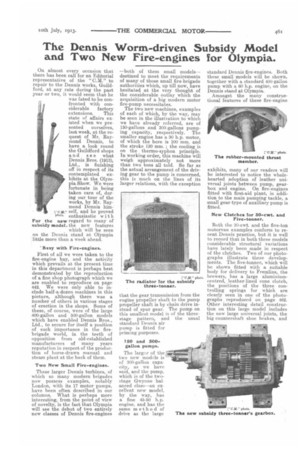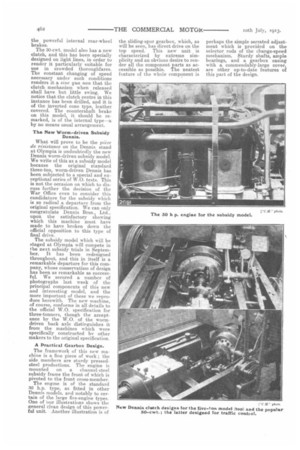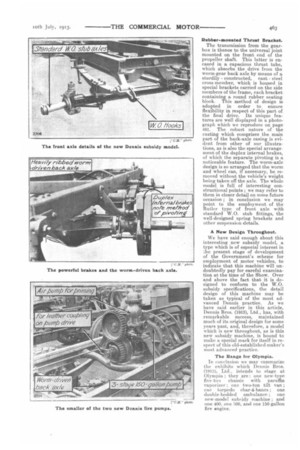The Dennis Worm-driven Subsidy Model and Two New Fire-engines for Olympia.
Page 23

Page 24

Page 25

If you've noticed an error in this article please click here to report it so we can fix it.
On almost every occasion that there has been call for an Editorial representative of the "C.M." to repair to the Dennis works, Guildford, at any rate during the past year or two, it would seem that he was fated to be confronted with con siderable factory extensions. This state of affairs existed when we presented ourselves, last week, at the request of Mr. Raymond Dennis, to have a look round the Guildford shops and see what Dennis Bros. (1913), Ltd., is finishing off in respect of its contemplated exhibits at the Olympia Show. We were fortunate in being taken care of, during our tour of the works, by Mr. Raymond Dennis him
self, and he proved ph*to, enthusiastic with For the new regard to many of subsidy model. the new features
which will be seen on the Dennis stand at Olympia little more than a week ahead.
'Busy with Fire-engines.
First of all we were taken to the fire-engine bay, and the activity which prevails at the present time in this department is perhaps best demonstrated by the reproduction of a fine shop photograph which we are enabled to reproduce on page 442. We were only able to include half-a-dozen machines in this picture, although there was a number of others in various stages of erection in the shops. Some of these, of course, were of the large 400-gallon and 500-gallon models which have enabled Dennis Bros., Ltd., to secure for itself a position of such importance in the firebrigade world, in the teeth of opposition from old-established manufacturers of many years reputation in respect of the production of horse-drawn manual and steam plant at the back of them.
Two New Small Fire-engines.
These larger Dennis turbines, of which so many modern brigades now possess examples, notably London, with its 17 motor pumps, have been often described in our columns. What is perhaps more interesting, from the point of view of novelty, is the fact that Olympia will see the debut of two entirely new classes of Dennis fire-engines —both of them small models— destined to meet the requirements of many of those small fire-brigade authorities which, up till now, have hesitated at the very thought of the considerable outlay which the acquisition of a big modern motor fire-pump necessitates.
The two new machines, examples of each of which, by the way, may be seen in the illustration to which we have already referred, are of 150-gallons and 300-gallons pumping capacity, respectively. The smaller engine has a 30 h.p. motor, of which the bore is 100 mm. and the stroke 130 mm. ; the cooling is on the thermo-syphon principle. In working order, this machine will weigh approximately not more than two tons all told. So far as the actual arrangement of the driving gear to the pump is concerned, this is much on the lines of its larger relations, with the exception
that the gear transmission from the engine propeller shaft to the pump propeller shaft is by chain drive instead of spur gear. The pump on this smallest model is of the threestage pattern, and the usual standard Dennis air pump is fitted for priming purposes.
150 and BOOgallon pumps.
The larger of the two new models is of 300-gallon capacity, as we have said, and the pump, which is of the twostage Gwynne balanced class—an excellent new model, by the way, has a fine 45-50 h.p. engine, and has the same method of drive as the large standard Dennis fire-engines. Both these small models will be shown, together with a standard 400-gallon pump with a 60 h.p. engine, on the Dennis stand at Olympia.
Amongst the many constructional features of these fire-engine exhibits, many of our readers will be interested to notice the wholehearted adoption of leather universal joints between pump, gearbox and engine. On fire-engines fitted with first-aid plant, in addition to the main pumping tackle, a small gear-type of auxiliary pump is fitted.
New Clutches for 30-cwt. and
Both the 30-cwt. and the five-ton motorvan examples conform to recent Dennis practice, but it is well to record that in both these models considerable structural variations have lately been made in respect of the clutches. Two of our photographs illustrate these developments. The five-tonner, which will be shown fitted with a suitable body for delivery to Fremlins, the brewers, has a large aluminiumcentred, leather-lined cone clutch, the positions of the three controlling springs for which are clearly seen in one of the photographs reproduced on page 462. Other interesting detail construction on this large model includes the new large universal joints, the big countershaft shoe brakes, and the powerful internal rear-wheel brakes.
The 30-cwt. model also has a new clutch, and this has been specially designed on light lines, in order to render it particularly suitable for use in crowded thoroughfares. The constant changing of speed necessary under such conditions renders it a sine qua non that the clutch mechanism when released shall have but little swing. We notice that the clutch centre in this instance has been drilled, and it is of the inverted cone type, leather covered. The countershaft brake on this model, it should be remarked, is of the internal type—a by no means usual arrangement.
The New Worm-driven Subsidy Dennis.
What will prove to be the piece de rsistance on the Dennis stand at Olympia is undoubtedly the new Dennis worm-driven subsidy model. We write of this as a subsidy model because the original standard three-ton, worm-driven Dennis has been subjected to a special and exceptional series of W.O. tests. This is not the occasion on which to discuss further the decision of the War Office even to consider this candidature for the subsidy which is so radical a departure from the original specification. We can only congratulate Dennis Bros., Ltd., upon the satisfactory showing which this machine must have made to have broken down the official opposition to this type of final drive.
The subsidy model which will be staged at Olympia will compete in the next subsidy trials in September. It has been redesigned throughout, and this in itself is a remarkable departure for this company, whose conservatism of design has been as remarkable as successfuL We secured a number of photographs last week of the principal components of this new and interesting model, and the more important of these we reproduce herewith. The new machine, of course, conforms in all details to the official W.O. specification for three-tonners, though the acceptance by the W.O. of the wormdriven back axle distinguishes it from the machines which were specifically constructed by other makers to the original specification.
A Practical Gearbox Design.
The framework of this new machine is a. fine piece of work ; the side members are sturdy pressedsteel productions. The engine is mounted on a channel-steel subsidy frame the front of which is pivoted to the front cross-member. The engine is of the standard 30 h.p. type, as fitted in other Dennis models, and notably to certain of the large fire-engine types. One of our illustrations shows the general clean design of this powerful unit. Another illustration is of the sliding-spur gearbox which, as will be seen, has direct drive on the top speed. This new unit is characterized by extreme simplicity and an obvious desire to render all the component parts as accessible as possible. The neatest feature of the whole component is
perhaps the simple serrated adjustment which is provided on the selector rods of the change-speed mechanism. Sturdy shafts, ample bearings, and a gearbox casing with a commendably-large cover, are other up-to-date features of this part of the design. Rubber-mounted Thrust Bracket.
The transmission from the gearbox is thence to the universal joint mounted on the front end of the propeller shaft. This latter is encased in a capacious thrust tube, which absorbs the drive from the worm-gear back axle by means of a sturdily constructed, cast steel cross-member, which is housed in special brackets carried on the side members of the frame, each bracket containing a round rubber seating block. This method of design is adopted in order to ensure flexibility in respect of this part of the final drive. Its unique features are well displayed in a photograph which we reproduce on page 461. The robust nature of the casting which comprises the main part of the back-axle easing is evident from other of our illustrations, as is also the special arrangement of the duplex internal brakes, of which the separate pivoting is a noticeable feature. The worm-axle design is so arranged that the worm and wheel can, if necessary, be removed without the vehicle's weight being taken off the axle. The whole model is full of interesting constructional points ; we may refer to them in closer detail on some future occasion ; in conclusion we may point to the employment of the Butler type of front axle with standard W.O. stub fittings, the well-designed spring brackets and other suspension details.
A. New Design Throughout.
We have said enough about this interesting new subsidy model, a type which is of especial interest in thc present stage of development of the Government's scheme for employment of motor vehicles, to indicate that this machine will undoubtedly pay for careful examination at the time of the Show. Over and above the fact that it is designed to conform to the W.O. subsidy specifications, the detail design of this machine may be taken as typical of the most advanced Dennis practice. As we have said earlier in this article, Dennis Bros, (1913), Ltd., has, with remarkable success, maintained much of its original design for some years past, and, therefore, a model which is new throughout, as is this new subsidy machine, is bound to make a special mark for itself in respect of this old-established maker's most advanced practice.
The Range for Olympia.
In conclusion we may summarize the exhibits which Dennis Bros. (1913), Ltd., intends to stage at Olympia ; they are: one new-type five-ton chassis with paraffin vaporizer ; one two-ton tilt van ; one torpedo char--banes; one double-bedded ambulance ; one new-model subsidy machine ; and one 400, one 300, and one 150-gallon fire engine.
































